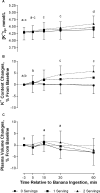Plasma potassium concentration and content changes after banana ingestion in exercised men
- PMID: 23182013
- PMCID: PMC3499889
- DOI: 10.4085/1062-6050-47.6.05
Plasma potassium concentration and content changes after banana ingestion in exercised men
Abstract
Context: Individuals prone to exercise-associated muscle cramps (EAMCs) are instructed to eat bananas because of their high potassium (K(+)) concentration and carbohydrate content and the perception that K(+) imbalances and fatigue contribute to the genesis of EAMCs. No data exist about the effect of bananas on plasma K(+) concentration ([K(+)](p)) or plasma glucose concentration ([glucose](p)) after exercise in the heat.
Objective: To determine whether ingesting 0, 1, or 2 servings of bananas after 60 minutes of moderate to vigorous exercise in the heat alters [K(+)](p) or [glucose](p) and whether changes in [K(+)](p) result from hypotonic fluid effluxes or K(+) ion changes.
Design: Crossover study.
Setting: Laboratory.
Patients or other participants: Nine euhydrated men (age = 27 ± 4 years, height = 180.3 ± 8.4 cm, mass = 84.9 ± 26.1 kg, urine specific gravity ≤ 1.006) without EAMCs volunteered.
Intervention(s): On 3 separate days, participants completed 60 minutes of moderate to vigorous cycling (temperature = 36.4°C ± 1.1°C, relative humidity = 19.4% ± 2.5%) and then ate 0 g (0 servings), 150 g (1 serving), or 300 g (2 servings) of bananas. Blood samples were collected at 3, 5, 15, 30, and 60 minutes postingestion.
Main outcome measure(s): The [K(+)](p), changes in plasma K(+) content, plasma volume changes, and [glucose](p).
Results: The [K(+)](p) differed between conditions at 60 minutes; 2 servings (4.6 ± 0.3 mmol/L [conventional unit = 4.6 ± 0.3 mEq/L]) was greater than 1 serving (4.5 ± 0.2 mmol/L [conventional unit = 4.5 ± 0.2 mEq/L]) and 0 servings (4.4 ± 0.3 mmol/L [conventional unit = 4.4 ± 0.3 mEq/L]) (P < .05). The [K(+)](p) was greater at 60 minutes than at 3 and 5 minutes in the 1-serving condition and was greater at 30 and 60 minutes than at 3 and 5 minutes in the 2-servings condition (P < .05). Percentage change in K(+) content was greater only at 30 and 60 minutes postingestion than at baseline in the 2-servings condition (4.4% ± 3.7% and 5.8% ± 2.3% increase, respectively) (P < .05). The plasma volume changes among conditions were unremarkable. The [glucose](p) was greater in the 2-servings condition than in all other conditions at 15, 30, and 60 minutes (P < .05).
Conclusions: The effect of banana ingestion on EAMCs is unknown; however, these data suggested bananas are unlikely to relieve EAMCs by increasing extracellular [K(+)] or [glucose](p). The increases in [K(+)](p) were marginal and within normal clinical values. The changes in [K(+)](p), plasma K(+) content, and [glucose](p) do not occur quickly enough to treat acute EAMCs, especially if they develop near the end of competition.
Figures


Similar articles
-
An Evidence-Based Review of the Pathophysiology, Treatment, and Prevention of Exercise-Associated Muscle Cramps.J Athl Train. 2022 Jan 1;57(1):5-15. doi: 10.4085/1062-6050-0696.20. J Athl Train. 2022. PMID: 34185846 Free PMC article. Review.
-
Electrolyte and plasma responses after pickle juice, mustard, and deionized water ingestion in dehydrated humans.J Athl Train. 2014 May-Jun;49(3):360-7. doi: 10.4085/1062-6050-49.2.23. Epub 2014 Feb 12. J Athl Train. 2014. PMID: 24955622 Free PMC article. Clinical Trial.
-
Electrolyte and plasma changes after ingestion of pickle juice, water, and a common carbohydrate-electrolyte solution.J Athl Train. 2009 Sep-Oct;44(5):454-61. doi: 10.4085/1062-6050-44.5.454. J Athl Train. 2009. PMID: 19771282 Free PMC article. Clinical Trial.
-
Plasma and electrolyte changes in exercising humans after ingestion of multiple boluses of pickle juice.J Athl Train. 2015 Feb;50(2):141-6. doi: 10.4085/1062-6050-50.2.07. Epub 2015 Jan 6. J Athl Train. 2015. PMID: 25562454 Free PMC article.
-
Gastric emptying after pickle-juice ingestion in rested, euhydrated humans.J Athl Train. 2010 Nov-Dec;45(6):601-8. doi: 10.4085/1062-6050-45.6.601. J Athl Train. 2010. PMID: 21062184 Free PMC article. Clinical Trial.
Cited by
-
Low-Osmolality Carbohydrate-Electrolyte Solution Ingestion Avoid Fluid Loss and Oxidative Stress After Exhaustive Endurance Exercise.Antioxidants (Basel). 2020 Apr 20;9(4):336. doi: 10.3390/antiox9040336. Antioxidants (Basel). 2020. PMID: 32326004 Free PMC article.
-
Hyperkalemia in ambulant postcardiac surgery patients during combined therapy with angiotensin-converting enzyme inhibitor, spironolactone, and diet rich in potassium: A report of two cases and review of literature.Ann Card Anaesth. 2019 Apr-Jun;22(2):162-168. doi: 10.4103/aca.ACA_65_18. Ann Card Anaesth. 2019. PMID: 30971598 Free PMC article. Review.
-
An Evidence-Based Review of the Pathophysiology, Treatment, and Prevention of Exercise-Associated Muscle Cramps.J Athl Train. 2022 Jan 1;57(1):5-15. doi: 10.4085/1062-6050-0696.20. J Athl Train. 2022. PMID: 34185846 Free PMC article. Review.
-
Exercise-Associated Muscle Cramps in the Tennis Player.Curr Rev Musculoskelet Med. 2020 Oct;13(5):612-621. doi: 10.1007/s12178-020-09662-8. Curr Rev Musculoskelet Med. 2020. PMID: 32720102 Free PMC article. Review.
References
-
- Norris FH, Jr, Gasteiger EL, Chatfield PO. An electromyographic study of induced and spontaneous muscle cramps. Electroencephalogr Clin Neurophysiol. 1956;9(1):139–147. - PubMed
-
- Stone MB, Edwards JE, Stemmans CL, Ingersoll CD, Palmieri-Smith RM, Krause BA. Certified athletic trainers' perceptions of exercise associated muscle cramps. J Sport Rehabil. 2003;12(4):333–342.
-
- Bergeron MF. Muscle cramps during exercise: is it fatigue or electrolyte deficit? Curr Sports Med Rep. 2008;7(4 suppl):S50–S55.
-
- Bergeron MF. Heat cramps: fluid and electrolyte challenges during tennis in the heat. J Sci Med Sport. 2003;6(1):19–27. - PubMed
-
- Stofan JR, Zachwieja JJ, Horswill CA, Murray R, Anderson SA, Eichner ER. Sweat and sodium losses in NCAA football players: a precursor to heat cramps? Int J Sport Nutr Exerc Metab. 2005;15(6):641–652. - PubMed
MeSH terms
Substances
LinkOut - more resources
Full Text Sources
Medical
Research Materials

